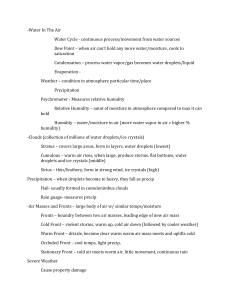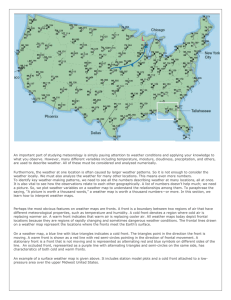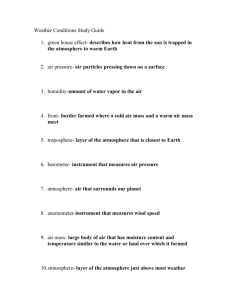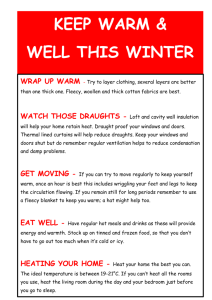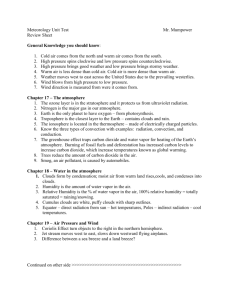Lesson 8: Meteorology II
advertisement
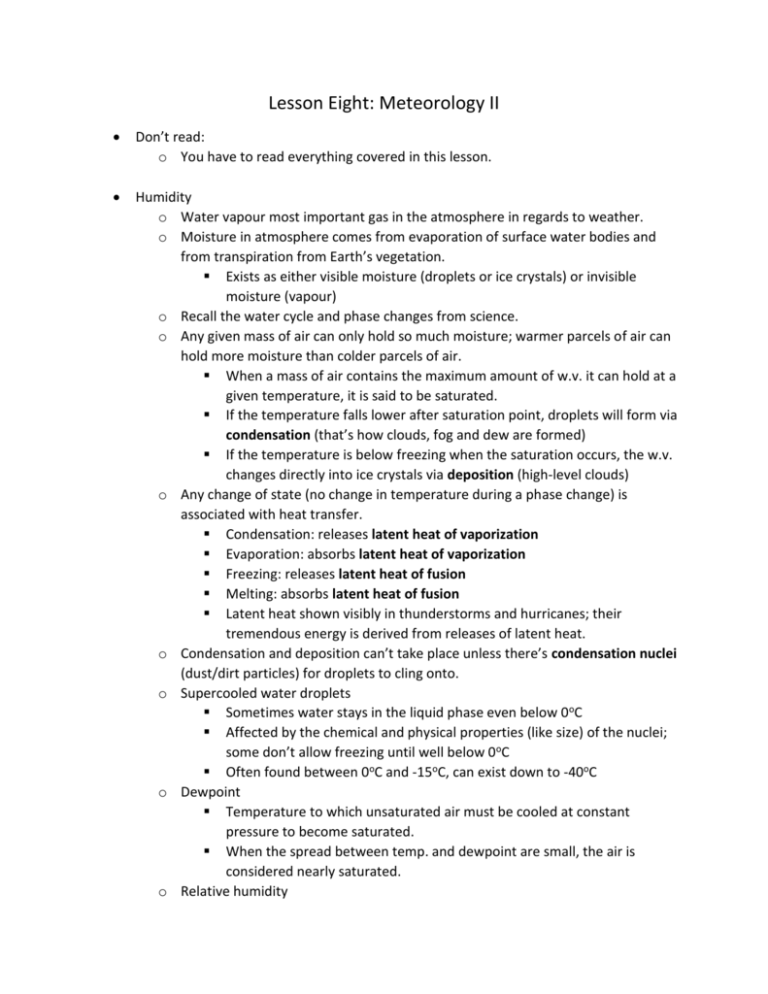
Lesson Eight: Meteorology II Don’t read: o You have to read everything covered in this lesson. Humidity o Water vapour most important gas in the atmosphere in regards to weather. o Moisture in atmosphere comes from evaporation of surface water bodies and from transpiration from Earth’s vegetation. Exists as either visible moisture (droplets or ice crystals) or invisible moisture (vapour) o Recall the water cycle and phase changes from science. o Any given mass of air can only hold so much moisture; warmer parcels of air can hold more moisture than colder parcels of air. When a mass of air contains the maximum amount of w.v. it can hold at a given temperature, it is said to be saturated. If the temperature falls lower after saturation point, droplets will form via condensation (that’s how clouds, fog and dew are formed) If the temperature is below freezing when the saturation occurs, the w.v. changes directly into ice crystals via deposition (high-level clouds) o Any change of state (no change in temperature during a phase change) is associated with heat transfer. Condensation: releases latent heat of vaporization Evaporation: absorbs latent heat of vaporization Freezing: releases latent heat of fusion Melting: absorbs latent heat of fusion Latent heat shown visibly in thunderstorms and hurricanes; their tremendous energy is derived from releases of latent heat. o Condensation and deposition can’t take place unless there’s condensation nuclei (dust/dirt particles) for droplets to cling onto. o Supercooled water droplets Sometimes water stays in the liquid phase even below 0oC Affected by the chemical and physical properties (like size) of the nuclei; some don’t allow freezing until well below 0oC Often found between 0oC and -15oC, can exist down to -40oC o Dewpoint Temperature to which unsaturated air must be cooled at constant pressure to become saturated. When the spread between temp. and dewpoint are small, the air is considered nearly saturated. o Relative humidity Ratio between actual w.v. present in the air to the amount which the same volume of air would hold if it were saturated (0 to 100%) When a mass of air is heated (at constant moisture), its relative humidity decreases. When a mass of air has moisture added to it (at constant temperature), its relative humidity increases The smaller the spread between temp and dewpoint, the higher the relative humidity. o Dew and Frost Vegetation cools by radiation at night to dewpoint Dew collects when temperature is above 0, frost forms when it’s below freezing Temperature o Earth’s surface is warmed by the short-wave radiation from the Sun (solar radiation). o The air above the Earth’s surface is warmed by the long-wave radiation from the Earth (terrestrial radiation). o Temperature varies across the globe based on several different factors. Diurnal variation Day-night cycle Solar radiation warms the ground during the day (solar radiation in > terrestrial radiation out) Solar radiation ceases during the night (terrestrial radiation > 0) so the surface cools Seasonal variation Tilt of the Earth affects angle of incidence of Sun’s rays during a day Summer = greater solar radiation than winter Latitude Sun is more directly overhead equatorial regions than at higher latitudes; greater solar insolation at lower latitudes. Tropics get more radiant energy than poles. Topography (terrain) Land surfaces absorb more solar radiation than water surfaces AND radiate radiation out more than water Vegetation acts as insulation Some solar radiation is reflected (affected by the albedo of the surface in question) Clouds o o o o Clouds can reflect incoming solar radiation, and trap outgoing terrestrial radiation How the atmosphere is heated Convection “Warm air rises, cool air descends” Air over warm surface becomes buoyant, rises; compensating flow of cold air descends to take its place. Mixes heat throughout the atmosphere. Advection Horizontal movement of an air parcel. Cold air moves over a warm surface, heated in its lowest layers by the warm earth. Turbulence Turbulence due to friction. Mixes heat throughout the atmosphere. Compression Descending air increases in atmospheric pressure, causing temperature to rise. Phenomenon called subsidence, common at the center of high pressure systems. Isotherms Lines on a weather map joining places of equal temperature. Density and Temperature Density defined as mass per unit volume. Warm air is less dense than cold air; can be explained by the Kinetic Molecular Theory from science Less dense fluids tend to rise above denser fluids, until its density matches that of the surrounding fluid. How the atmosphere is cooled Lapse rate defined as the rate of decrease of temperature with height. Radiation Nighttime release of heat towards space Affects no more than the lower few thousand feet of the atmosphere. Reduced if clouds are present. Advection Warm air moving over a colder surface. Adiabatic expansion Parcel of air rises due to some external forcing, expands due to lower pressure surrounding the parcel Expansion causes it to cool without a transfer of heat. o Adiabatic lapse rates Dry adiabatic lapse rate: 3oC/1000’ Saturated lapse rate: 1.5oC/1000’ Because moist air is more insulating, it cools at a slower rate with increase in height. Average lapse rate: 2oC/1000’ ICAO lapse rate: 1.98oC/1000’ o Inversions and Isothermal Layers Normally temperature decreases with height Sometimes, warmer air may be found at a higher altitude; such a reversal is called an inversion An isothermal layer is one where the temperature remains constant throughout a layer of some depth. Ground based inversions favour poor visibility by trapping fog, some and other obstructions in the lower levels of the atmosphere. Stability o Normal flow of air is generally horizontal. o But external forcings can force air to move vertically. o Air that resists upward or downward displacement and tends to return to its original horizontal level is said to be stable. o Vertical currents associated with an unstable condition may cause turbulence and thunderstorms. o If a mass of rising air is cooler than the air around it, it is considered stable. If disturbed, it will go back to its original position. o Unstable air is indicated by a steep lapse rate. o Flight characteristics of stable air Poor low-level visibility Stratus type cloud Steady precip Steady winds which change markedly with height Smooth flying conditions o Flight characteristics of unstable air Good visibility Heap type cloud (cumuliform) Showery precip Gusty winds Turbulence may be moderate to severe o Lifting agents Convection Orographic lift (i.e. mountain lift) Frontal lift (when different masses meet, warm air forced aloft the by advancing/receding wedge of cold air) Mechanical turbulence Convergence (low pressure area, winds blow across isobars into the centre of the low, where the buildup of air forces it to rise) o Read Vapour Trails Air Masses o Defined as a section of the troposphere with uniform properties of temperature and pressure in the horizontal. o Takes on original properties from the surface over which it has formed. o Air mass formed over a large body of water is moist, called maritime air o Air mass formed over land is dry, called continental air o Three main sources of air masses of North America The Arctic Region (North Pole to permafrost line) The Polar Region (Permafrost line to where mean temperature is 10oC) Tropical Region (lies below 30oN) o Air masses of North America Continental Arctic (cA) and Continental Polar (cP) Cold dry air masses which originate over the intensely cold ice and snow covered surface of the north; brings a cold wave southwards Maritime Arctic (mA) and Maritime Polar (mP) Cold air masses formed over the Arctic, acquire moisture as they move south over the cold waters of the North Pacific/North Atlantic mP warmer and moister than mA Maritime Tropical (mT) Warm, moist air from the tropical seas/oceans moving northwards. In winter, mP, mA and cA are most common In summer, mA, mP and mT are common. o Weather in an air mass Moisture content, cooling process and stability of the air affect the weather in an air mass Maritime air has a high moisture content and cloud/precip is common o Read Modification of Air Masses Fronts o o o o o o o o o o In general Cold Air Mass o Associated with unstable air/instability, has all the properties of unstable air Warm Air Mass o Associated with stable air/stability, has all the properties of stable air. Transition zone between two different air masses called a front Responsible for a lot of weather changes Read Polar Front Sloping side of the cold air is called a frontal surface Development of a Frontal Depression Air on northern side termed arctic/polar air, normally cold and dry Air on southern side termed tropical air, normally warm and moist Difference in properties of these two air masses results in a surface of discontinuity Essentially, the warm air extends into the cold air, the cold air extends into the warm air, and a frontal wave forms between the cold and warm air, resulting in a depression (low pressure area) Cold front is that part of a frontal system along which cold air is advancing and is shown as blue triangles on the weather map Warm front is the part of a frontal system along which cold air is retreating and is shown as red semi-circles on the weather map Occluded front is when a cold front moves faster than the warm front and catches up with it; shown as alternating blue triangles and red circles Stationary front is where the frontal surface doesn’t move; shown as alternating blue triangles/red circles facing in opposite directions Warm front Warm air advances on retreating cold air Warm air rises over the cold air in a long, gentle slope; cloud formation typically 500 nm or more in advance of it Moves at relatively slow speeds, affects a vast area for a considerable length of time If warm air is moist and stable, CCANS indicates the passing of a warm front Cirrus o o o o o Cirrostratus Altostratus Nimbostratus Stratus If warm air is moist and somewhat unstable, thunderstorms may be embedded in the stratiform layers Passing of a warm front marked by a rise of temp, and the sky becomes relatively clear Cold front When a mass of cold air overtakes a mass of warm air, the cold dense air forces the warm air up (steep slope) Width of cloud cover only 50 nm ahead of the front Showery precipitation, usually associated with cumuliform development Passing of cold front marked by a sharp fall in temp and rapid clearing Stationary front Some part of a front along which cold air is neither advancing nor retreating No motion to cause front to move because the opposing air masses of are of equal pressure Surface wind tends to blow parallel to front, weather conditions similar to those associated with a warm front though generally less intense and extensive Occluded front Cold front overtakes a warm front and lifts the warm sector off the ground Cool air catching up to colder air: warm occlusion Characteristics of a warm front, where cool air rides atop the cold air, both lifting the trapped warm air in between up Cold air catching up to cool air: cold occlusion Characteristics of a cold front, where cold air forces the cooler air and warmer air up Warm air caught in between called a trowal (trough of warm air aloft) Read Upper Front Frontal Weather Actual weather associated with a front may extend over an area of many miles; don’t think that the line drawn on the map is where all the weather happens! Frontal zone aloft called frontal surface, frontal zone on the ground called the front Frontogenesis means a front which is increasing in intensity Frontolysis means a front which is decreasing in intensity Cold front Long line of cumulus clouds on western horizon usually an indication of an approaching cold front. Surface wind o Will always veer as the front passes. Gustiness may be associated with windshift Temperature o Temperature drops Visibility o Usually improves after passage of a cold front Pressure o Approach marked by a decrease in pressure, passing marked by a rise in pressure Turbulence o Associated with a cold front, although thunderstorms are not always present Precipitation o Frontal rain/snow usually narrow, showery in character Icing in turbulent cumulus clouds may be severe Squall line o Long line of squalls and TS which sometimes accompanies the passage of a cold front is called a squall line o Usually associated with a fast moving cold front that is undercutting an unstable warm air mass o Form anywhere from 50 nm to 300 nm in advance of front itself Warm front CCANS Windshift o Wind will veer with passing of a warm front, change will be much more gradual than cold front Temperature o Gradual rise in temp Visibility o Low ceilings and restricted vis associated with warm fronts Turbulence o Thunderstorms can be embedded in the main cloud deck, and those storms would be responsible for turbulence, if any Precipitation o Begins in As layer of cloud, precip gets heavier as front gets closer Read Weather at Trowals and Upper Fronts Precipitation and Fog o Precip occurs when water droplets grow sufficiently in size and weight to fall due to gravity o Vertical air currents can cause droplets to move about, collide with other drops and grow in size until they fall as rain (process called coalescence) o In stratiform clouds, lack of vertical air currents means that drops can’t coalesce into bigger drops, and thus fall as drizzle o Steady precipitation falls from a layer of stratiform cloud o A shower (sudden burst of heavy precip) falls from cumuliform clouds o Large clouds like thunderstorms can be divided into an ice crystal region (top), a snow and supercooled water drop region (middle) and a water region (bottom) o Drizzle Very small drops which seem to float At or below freezing level, drizzle will be supercooled and freeze on impact (freezing drizzle) o Rain Large water droplets Freezing rain is composed of supercooled water droplets that freeze after striking an object o Hail When a supercooled water drop collides with an ice crystal, it at once freezes on the latter, imprisoning a little air which causes it to freeze in the form of soft ice Water freezes on it in the form of hard, transparent ice Finally the ball falls out of the cloud as a hailstone, a hard, transparent layer of ice covering a soft, white core Often encountered in a thunderstorm o Snow pellets (soft hail) If water region lying below supercooled region of a cloud is not deep, hailstone doesn’t acquire that hard, transparent outer layer. Soft, white ice. o Snow o o o o W.v. in air deposits directly into ice crystals Formed of an agglomeration of ice crystals and usually have a hexagonal/star-like shape Snow grains are tiny snow crystals that have acquired a coating of rime Fall from non-turbulent clouds Ice prisms Tiny ice crystals in the form of needles Can fall from a cloudless sky Exist in stable air masses and at very low temps Ice pellets Formed by the freezing of raindrops Generally rebound when striking the ground Read Precipitation and Cloud type Fog Stratus in contact with the ground Formed when air is cooled below dewpoint, or if moisture is added to the air Most likely to occur in coastal areas where moisture is abundant Types of Fog (RAUSIP) RAU – Formed by cooling SIP – Formed by addition of moisture Radiation Fog o Formed on clear nights with light winds o Ground cools losing heat through radiation o Air in direct contact with ground cools, and if air is moist and temperature is lowered below dew point, fog will form o Forms typically only over ground (ground fog) o Dissipates within a few hours after sunrise as the sun warms the earth and radiation heating causes the temp to rise Advection Fog o Caused by drifting of warm damp air over a colder land or sea surface o Can persist for days and covers a wide area Upslope Fog o Caused by cooling of air due to expansion as it moves up a slope; light winds necessary Steam Fog o Forms when cold air passes over a warm water surface; warm surface evaporates into the cold air, causing the colder air to become saturated Ice Fog o Forms in moist air during extremely cold, calm conditions. o Formed by deposition, typically when w.v. is added to the air through fuel combustion. Precipitation-Induced Fog o Addition of moisture to the air through evaporation of rain or drizzle o Known as frontal fog as well Read Haze and Visibility (focus on the visibility definitions, as well as the difference between VMC and IMC)


